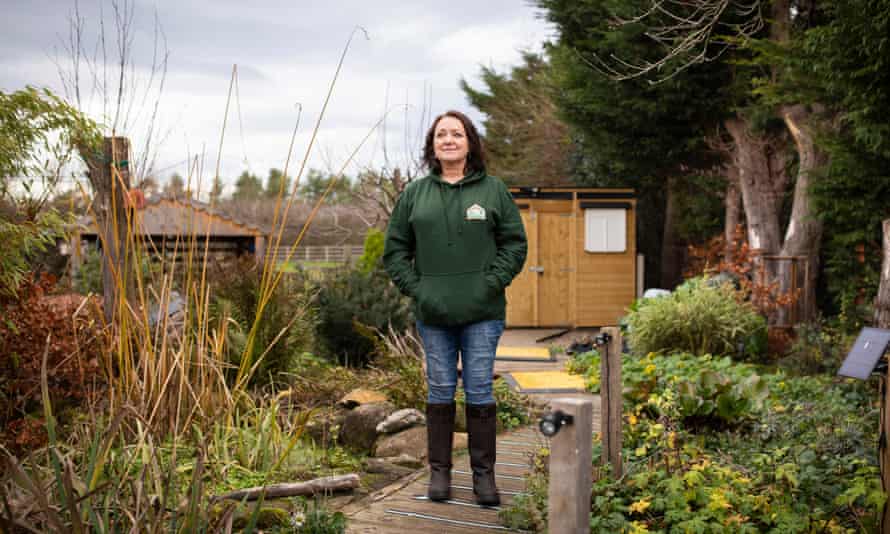
Dudley the hedgehog was found abandoned by the roadside in June last year. He was a newborn, scarcely 48 hours old. He weighed just 37 grams. His eyes and ears wouldn’t open. A kind stranger knew just where to take him.
Sandra Lowe snapped on some blue surgical gloves and went to work. She mixed up a milk solution, for nutrition, with cold fennel tea, to stop the bloat. Dudley had to be fed with a syringe every two hours. Lowe worked on him all night.
Newborns are the hardest patients to treat. Lowe says: “When you get a call about a baby you think, ‘Oh God, that’s no sleep for me, for a fortnight.’” Her husband, John, helped with the night feeds. She didn’t expect this one to survive. But against the odds, he did. She discharged him just over a month later. “We called him Big Dudley,” says Lowe. “A beautiful hog.”
Lowe, a 59-year-old retired psychiatric nurse, is the founder and chief medical officer of Hope for Hedgehogs, a 13-hutch residential hospital near Ryton, Tyne and Wear, which everyone calls Lowe’s hedgehog hospital. Here, in a converted shed, up to 13 infirm and premature hedgehogs are cared for by Lowe and her team of volunteers. She says: “I tuck them in at night. I know, it’s embarrassing, but I can’t sleep unless I make sure they’re OK. Do they have enough blankets? Does their heat pad need warming?”
At the hospital, the hogs (as they are called in the hedgehog world) receive dedicated medical care. “Sandra works tirelessly day and night to look after these sick hogs, feeding babies, administering medication and tending wounds,” says volunteer Maria Gilroy. “She is also great fun to work with, and teaches us lots.”
Looking after these spiny mammals occasionally results in injury. Last year Lowe had to have emergency surgery to remove a quill embedded in her thumb. “They kept me in overnight and put me on antibiotics,” she says, aghast.
Lowe emphasises that the hogs don’t intentionally hurt her. “They’re gentle, submissive animals. Shy loners. They just want to be left alone.” Hogs get a rough deal, she points out: “We’ve taken their habitat. We put down plastic lawns, so they can’t forage.”
Then there are the other dangers: “Slug pellets. Poison. Pesticides. Cars. Gutters.” In 2020, hedgehogs were added to the International Union for Conservation of Nature’s Red List for endangered British mammals.
Lowe also educates the community about how to create hog-friendly habitats in their gardens. “Lots of people spend £100 on a store-bought hedgehog house,” she says, “which is wonderful, but it’s better to donate that money to a rescue and make one yourself.” All you need is a plastic storage box: cut a five-inch hole in it, and put bowls of cat food and water inside. Weigh down the box with bricks to stop the foxes flipping it over, and voilà: a hedgehog feeding station can be yours.
Lowe’s hospital is funded entirely by donations and, occasionally, her own savings. Caring for the hogs is expensive. There’s food, heat pads, bedding and cleaning supplies to pay for. On the day we speak, Lowe has spent £200 on medication. When I ask how much of her own money she has put into the hospital, she shrieks with laughter. “You’re not printing that!” she says. “My husband will go bonkers.”
Lowe founded the hospital in 2018: a nearby rescue had to close down, and she offered her garden for a replacement. Since then, she has treated 153 hogs. Not all can be saved; the deaths are upsetting, but Lowe tries to focus on the hogs that made it through. Like Mad Marilyn: she had been to a few different rescues, without much luck, but after a year of careful feeding, Lowe got her to the point where she could be released. “I loved Mad Marilyn,” says Lowe. “She used to lie on my knee and I could tickle her tummy. She was gorgeous.”
Lowe’s operations are thriving but overstretched. As they only have one shed, hogs in need of intensive care are housed alongside those resting up before being released. In these busy quarters many of these recovering hogs will have struggled to hibernate over the winter and gained weight. “Some of the male hogs have boobs because they just sit around stuffing their faces when they shouldn’t be,” says Lowe.
Wayfair agrees to supply Lowe with an 8ft by 10ft garden shed, to be used as a quiet space where recovering hogs can hibernate.
Sign up to our Inside Saturday newsletter for an exclusive behind the scenes look at the making of the magazine’s biggest features, as well as a curated list of our weekly highlights.<br>
“I’m so happy,” she says. “It will make a huge difference. It means we can rescue more hogs, and get them out there, and they can have babies. It’s just wonderful when you see an animal that would have died being released into the wild.”
Want to nominate someone for Guardian angel? Email us – with their permission – and suggest a treat at [email protected]



